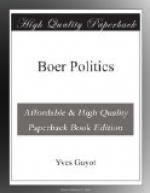I borrow the following figures from the supplement to The Critic of July 8th, 1899.
Let us take the last five years:—
Gross Profits. Dividend
to Paid to Boer
Shareholders. Government.
1894 L7,930,481 L1,595,963 L2,247,728 1895
8,768,942 2,329,941 2,923,648 1896
8,742,811 1,918,631 3,912,095 1897
11,514,016 2,923,574 3,956,402 1898 15,942,573
4,999,489 3,329,958
-----------
----------- -----------
L52,898,823
L13,767,598 L16,370,387
===========
=========== ===========
Thus upon L52,898,823 worth of gold produced between the years 1894 and 1898 only 25 per cent. of this amount went to the shareholders, 30 per cent. was paid to the Transvaal Government, while the cost of production absorbed 45 per cent. The two last figures show that about 75 per cent., that is to say, three-quarters of the entire production remained in the Transvaal; and we have only taken the average of the last few years, during which the cost of production has been reduced to a minimum, thanks to the perfecting of the methods of working.
Let us add that while according to the above table in 1898 the estimate of the revenue was L3,329,000, the expenditure rose to L3,476,000. In 1899, the estimate of the revenue was L4,087,000.
From 1894-97 the amount paid directly into the Transvaal Exchequer had exceeded the shareholders’ dividends; and when the reverse happened in 1898, the Government of Pretoria determined to put that matter right.
6.—Cost of Production and the Transvaal.
Dr. Kuyper also complained that the entire cost of production was not absorbed by the Transvaal. In his statement of January 26th 1899, Mr. Rouliot proved that the greater portion was in point of fact expended there. He gave the following figures concerning the expenditure of fifty-six companies in 1898.
The mines had only imported direct to the amount of L369,000, paid for machinery, which could only be constructed in Europe, and for Cyanide, to avoid having to buy the latter from a local trust, which raised the price 100 per cent.
Through local firms they had imported machinery and certain products to the amount of L324,438. From local merchants they had bought machinery, &c., to the amount of L2,487,660. They had paid L767,600 to the Dynamite Monopoly. They had distributed L3,329,000 in salaries to their employes, native or European. If we take it that the expenditure of the sixty other Mining Companies, gold or coal, in the vicinity of Johannesburg, was similar to the above, we have a total of something like nine million pounds sterling put in circulation, plus purchases of dynamite, plus merchandise bought through the medium of local tradespeople. Thus we see that the bulk of the cost of production actually remained in the Transvaal.




